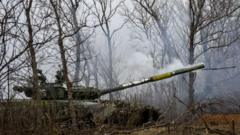Article Text:
The alarming signs began appearing along the shores of Alaska when thousands of common murres—a species of sleek black-and-white seabirds—were found lifeless. In 2015 and 2016, wildlife officials recorded the tragic loss of 62,000 undernourished murres that drifted ashore from California to Alaska. The rapid investigation into the die-off revealed an unsettling trend, pinpointing an unprecedented marine heat wave as the main instigator of this avian catastrophe.
In a groundbreaking study published recently in the journal Science, researchers unveiled detailed insights about the fate of these birds amid the turmoil created by what is now infamously known as "the Blob." The profound impact of this record heat wave on the marine ecosystem has raised alarms about the dire circumstances that wildlife, specifically seabirds, face in the context of climate change.
According to Heather Renner, a supervisory wildlife biologist involved in the study, the findings exceeded what scientists initially anticipated. The research confirmed that approximately half of Alaska's common murres—estimated at four million birds—suffered from the effects of the extreme marine heat wave, now believed to be the largest die-off recorded among any single wild bird or mammal species.
Alaska is home to a significant segment of the global common murre population, accounting for about 25% of it. The series of studies conducted over the years points to a cascade of ecological disruptions caused by the warmer waters, adversely affecting various marine organisms from minuscule plankton to massive humpback whales. For common murres, this surge in ocean temperature proved catastrophic as it precipitated the collapse of the fish populations upon which they heavily rely for sustenance.
As wildlife advocates and researchers continue to dissect the implications of this ecological disaster, the fate of the common murres sends a clear message regarding the urgent need for systemic changes to address and combat climate-induced perturbations in our oceans.
The alarming signs began appearing along the shores of Alaska when thousands of common murres—a species of sleek black-and-white seabirds—were found lifeless. In 2015 and 2016, wildlife officials recorded the tragic loss of 62,000 undernourished murres that drifted ashore from California to Alaska. The rapid investigation into the die-off revealed an unsettling trend, pinpointing an unprecedented marine heat wave as the main instigator of this avian catastrophe.
In a groundbreaking study published recently in the journal Science, researchers unveiled detailed insights about the fate of these birds amid the turmoil created by what is now infamously known as "the Blob." The profound impact of this record heat wave on the marine ecosystem has raised alarms about the dire circumstances that wildlife, specifically seabirds, face in the context of climate change.
According to Heather Renner, a supervisory wildlife biologist involved in the study, the findings exceeded what scientists initially anticipated. The research confirmed that approximately half of Alaska's common murres—estimated at four million birds—suffered from the effects of the extreme marine heat wave, now believed to be the largest die-off recorded among any single wild bird or mammal species.
Alaska is home to a significant segment of the global common murre population, accounting for about 25% of it. The series of studies conducted over the years points to a cascade of ecological disruptions caused by the warmer waters, adversely affecting various marine organisms from minuscule plankton to massive humpback whales. For common murres, this surge in ocean temperature proved catastrophic as it precipitated the collapse of the fish populations upon which they heavily rely for sustenance.
As wildlife advocates and researchers continue to dissect the implications of this ecological disaster, the fate of the common murres sends a clear message regarding the urgent need for systemic changes to address and combat climate-induced perturbations in our oceans.






















